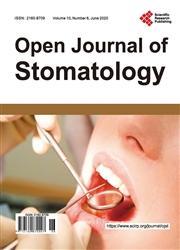Development of a Photodynamic Diagnosis Method for Oral Squamous Cell Carcinoma Using 5-Aminolevulinic Acid and a Luminescence Plate Reader
引用次数: 1
Abstract
Purpose: To establish a simple and accurate photodynamic diagnosis (PDD) method for oral squamous cell carcinoma (OSCC). Methods: OSCC cell lines HSC-2, HSC-3, HSC-4, and Sa3, and normal human oral keratinocytes (HOK) were used. First, we examined the amount of cells needed to detect differences in fluorescence intensities for PDD. OSCC cell lines were adjusted to concentrations of 1 × 104 (104), 1 × 105 (105), and 1 × 106 (106) cells/ml. The experimental groups comprised a group with 5-aminolevulinic acid (5-ALA (+)), and a group without 5-ALA (5-ALA (-)). For each OSCC cell line, 100 μl of each concentration of cells of the 5-ALA groups was seeded onto fluorescence plates, and fluorescence intensity was measured at 60-min intervals for 240 min. Results are expressed as the ratio of fluorescence intensity in 5-ALA (+) to 5-ALA (-). As cells at the concentration of 106 cells/ml provided the clearest results, fluorescence intensities of all cell lines were measured using this concentration at 20-min intervals for 700 min using the same methods. Results: The 5-ALA (+) to (-) ratio increased in a cell concentration-dependent manner at 240 min; the ratio was highest with 106 cells/ml and lowest with 104 cells/ml. With 106 cells/ml in the 5-ALA (+) group, fluorescence intensity increased in a metabolic time-dependent manner; the increase was highest in HSC-2 cells, followed by HSC-4 cells, HSC-3 cells, Sa3 cells, and HOK. Fluorescence intensity was significantly enhanced after 40 min in HSC-2, HSC-3, and HSC-4 cells, after 60 min in Sa3 cells, and after 100 min in HOK compared to the 5-ALA (-) group (P < 0.05). Moreover, fluorescence intensity was significantly increased in OSCC cell lines compared to HOK after 40 min. Conclusion: Early detection of OSCC is possible by screening only microplate reader measurements of fluorescence intensity for PDD.5-氨基乙酰丙酸光动力学诊断口腔鳞状细胞癌方法的建立及荧光平板读数器
目的:建立一种简单、准确的口腔鳞状细胞癌(OSCC)光动力诊断方法。方法:使用OSCC细胞系HSC-2、HSC-3、HSC-4和Sa3,以及正常人口腔角质形成细胞(HOK)。首先,我们检查了检测PDD荧光强度差异所需的细胞数量。将OSCC细胞系调节至1×104(104)、1×105(105)和1×106(106)个细胞/ml的浓度。实验组包括含有5-氨基乙酰丙酸的组(5-ALA(+))和不含有5-ALA的组(5-ALA(-))。对于每个OSCC细胞系,将100μl 5-ALA组的每种浓度的细胞接种到荧光板上,并以60分钟的间隔测量240分钟的荧光强度。结果表示为5-ALA(+)与5-ALA的荧光强度之比。由于浓度为106个细胞/ml的细胞提供了最清晰的结果,因此使用相同的方法以20分钟间隔700分钟使用该浓度测量所有细胞系的荧光强度。结果:5-ALA(+)与(-)的比值在240分钟时呈细胞浓度依赖性增加;该比率最高为106个细胞/ml,最低为104个细胞/ml。5-ALA(+)组为106个细胞/ml,荧光强度以代谢依赖性方式增加;HSC-2细胞的增幅最高,其次是HSC-4细胞、HSC-3细胞、Sa3细胞和HOK。与5-ALA(-)组相比,HSC-2、HSC-3和HSC-4细胞在40分钟后、Sa3细胞在60分钟后和HOK细胞在100分钟后的荧光强度显著增强(P<0.05)。此外,OSCC细胞系在40分钟之后的荧光强度与HOK相比显著增加。结论:通过仅筛选PDD荧光强度的微孔板读数器测量,可以早期检测OSCC。
本文章由计算机程序翻译,如有差异,请以英文原文为准。
求助全文
约1分钟内获得全文
求助全文

 求助内容:
求助内容: 应助结果提醒方式:
应助结果提醒方式:


